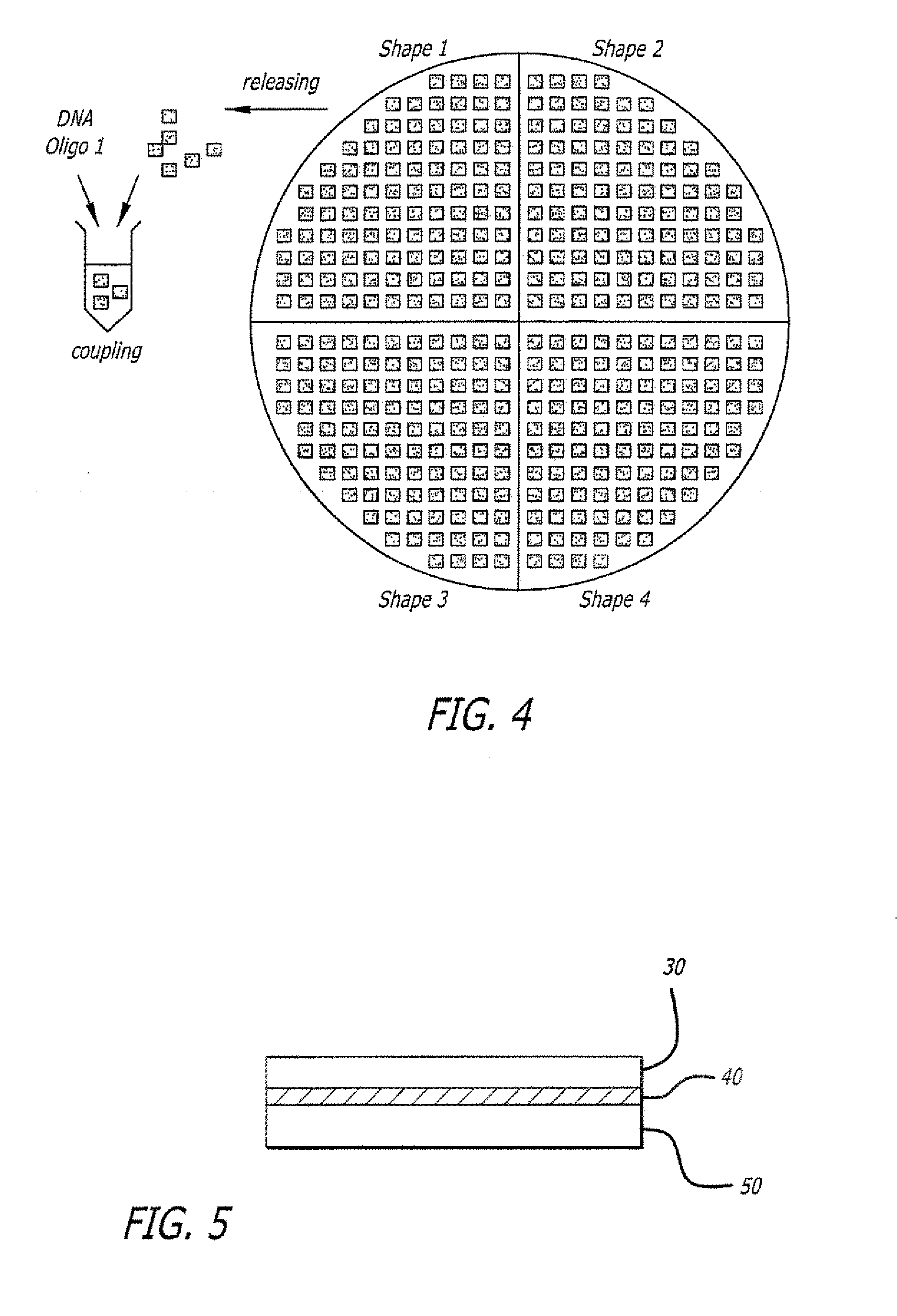Tracers and assembly for labeling chemical or biological molecules methods and kits using the same
a technology of tracer and chemical or biological molecules, applied in the field of tracer for chemical or biological molecules or materials, to achieve the effect of simple tracking, more flexibility in experimental design and related scale efficiency
- Summary
- Abstract
- Description
- Claims
- Application Information
AI Technical Summary
Benefits of technology
Problems solved by technology
Method used
Image
Examples
example 1
Parallel Handling of Shape Encoded Particles for Massively Multiplexed Assays
[0086]In doing a multiplexed assay as above, a special set of parallel handling procedures that maintain high throughput is employed. Each distinct shape is fabricated in bulk quantities, undergoes a attachment reaction to form a shape-probe conjugate, and all these preparations are pooled these to form a master mixture of encoded probes. This mixture is dispensing in (randomly sampled) aliquots of complete probe sets to perform individual, and the results of each assay are read with an automated imaging system and shape recognition software. According to the present disclosure there is shown this emphasizes a unique way to maintain a high degree of parallel handling of the particles through fabrication, probe-attachment, and reading, in contrast to ever handling the particles individually.
[0087]Likewise disclosed is a method for massively multiplexing assays which is not constrained by space limitations an...
example 2
A Method of Encoding Particles that Allows Recognition by One-Bit Imaging
[0089]The present inventors disclose a process using SEP's robust enough to manufacture via etching, that maximizes particle encoding capacity while preserving a special free region optimal for probe attachment / detection, and that reduces the chances of engraved features “clogging” with debris. In addressing these longstanding needs a preferred form of shape encoding or particle identification is disclosed according to the instant teachings. If the goal is to image using a one-bit (“black and white”) image system (=simple and robust for recognition) and do robust etching (=simply cut all the way through, which is robust to do and image, versus an etched serial number or mark, which is harder to control and image), and preserve viewable area for the probe but maximizes the coding capacity (=make particle fiat, and put the etched features on the edge where there is most room, reserve interior for probe attachment...
example 3
Shape Encoded Particles for Tracking the Identity of Reporter Probes in a Massively Multiplexed Reporter Assay
[0090]The present disclosure further contemplates specialization of the type of assay, if such is needed. The present teachings are directed to reporter assays, in which a probe material is bound to the particles, the assay modifies the state of the bound probe material, and this modification is registered by a detectable reporter. This covers not only binding assays, where the state modification is binding to a target, but also enzyme activity assays, where the assay looks to see if an enzyme modifies a substrate, or proliferation assays, where the assays looks at whether cells replicate or die, etc.
PUM
| Property | Measurement | Unit |
|---|---|---|
| diameter | aaaaa | aaaaa |
| diameter | aaaaa | aaaaa |
| size | aaaaa | aaaaa |
Abstract
Description
Claims
Application Information
 Login to View More
Login to View More - R&D
- Intellectual Property
- Life Sciences
- Materials
- Tech Scout
- Unparalleled Data Quality
- Higher Quality Content
- 60% Fewer Hallucinations
Browse by: Latest US Patents, China's latest patents, Technical Efficacy Thesaurus, Application Domain, Technology Topic, Popular Technical Reports.
© 2025 PatSnap. All rights reserved.Legal|Privacy policy|Modern Slavery Act Transparency Statement|Sitemap|About US| Contact US: help@patsnap.com



